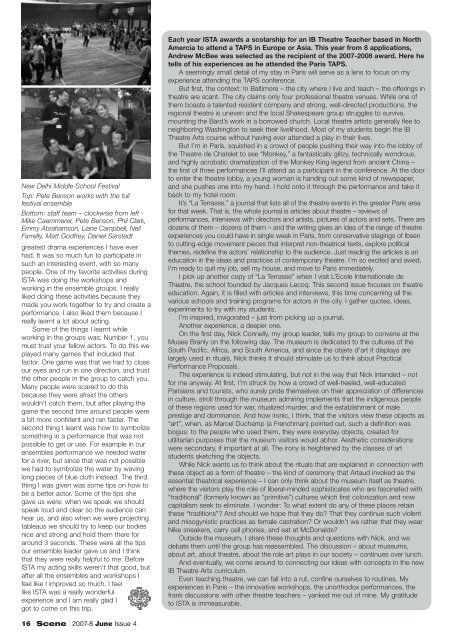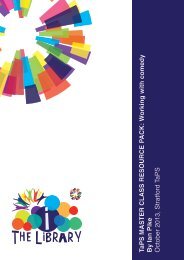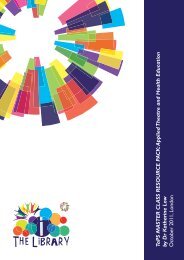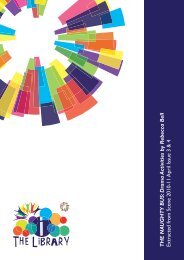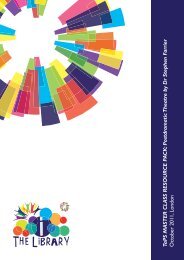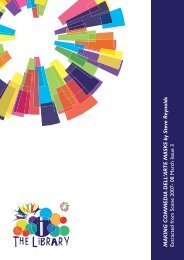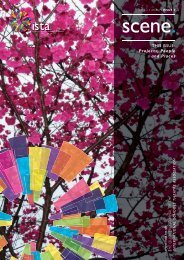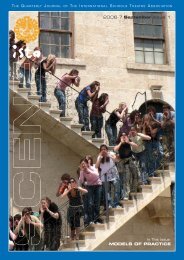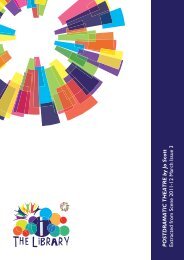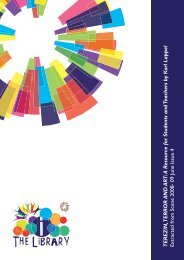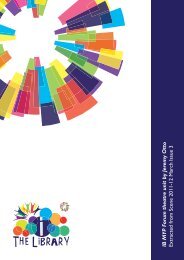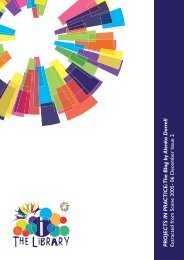ISTA-Scene June 08
ISTA-Scene June 08
ISTA-Scene June 08
- No tags were found...
Create successful ePaper yourself
Turn your PDF publications into a flip-book with our unique Google optimized e-Paper software.
New Delhi Middle School FestivalTop: Pete Benson works with the fullfestival ensembleBottom: staff team – clockwise from left -Mike Caemmerer, Pete Benson, Phil Clark,Emmy Abrahamson, Liane Campbell, NeilFarrelly, Matt Godfrey, Daniel Sarstedtgreatest drama experiences I have everhad. It was so much fun to participate insuch an interesting event, with so manypeople. One of my favorite activities during<strong>ISTA</strong> was doing the workshops andworking in the ensemble groups. I reallyliked doing these activities because theymade you work together to try and create aperformance. I also liked them because Ireally learnt a lot about acting.Some of the things I learnt whileworking in the groups was: Number 1, youmust trust your fellow actors. To do this weplayed many games that included thatfactor. One game was that we had to closeour eyes and run in one direction, and trustthe other people in the group to catch you.Many people were scared to do thisbecause they were afraid the otherswouldn’t catch them, but after playing thegame the second time around people werea bit more confident and ran faster. Thesecond thing I learnt was how to symbolizesomething in a performance that was notpossible to get or use. For example in ourensembles performance we needed waterfor a river, but since that was not possiblewe had to symbolize the water by wavinglong pieces of blue cloth instead. The thirdthing I was given was some tips on how tobe a better actor. Some of the tips shegave us were: when we speak we shouldspeak loud and clear so the audience canhear us, and also when we were projectingtableaus we should try to keep our bodiesnice and strong and hold them there foraround 3 seconds. These were all the tipsour ensemble leader gave us and I thinkthat they were really helpful to me. Before<strong>ISTA</strong> my acting skills weren’t that good, butafter all the ensembles and workshops Ifeel like I improved so much. I feellike <strong>ISTA</strong> was a really wonderfulexperience and I am really glad Igot to come on this trip.Each year <strong>ISTA</strong> awards a scolarship for an IB Theatre Teacher based in NorthAmercia to attend a TAPS in Europe or Asia. This year from 8 applications,Andrew McBee was selected as the recipient of the 2007-20<strong>08</strong> award. Here hetells of his experiences as he attended the Paris TAPS.A seemingly small detail of my stay in Paris will serve as a lens to focus on myexperience attending the TAPS conference.But first, the context: In Baltimore – the city where I live and teach – the offerings intheatre are scant. The city claims only four professional theatre venues. While one ofthem boasts a talented resident company and strong, well-directed productions, theregional theatre is uneven and the local Shakespeare group struggles to survive,mounting the Bard’s work in a borrowed church. Local theatre artists generally flee toneighboring Washington to seek their livelihood. Most of my students begin the IBTheatre Arts course without having ever attended a play in their lives.But I’m in Paris, squished in a crowd of people pushing their way into the lobby ofthe Theatre de Chatelet to see “Monkey,” a fantastically glitzy, technically wondrous,and highly acrobatic dramatization of the Monkey King legend from ancient China –the first of three performances I’ll attend as a participant in the conference. At the doorto enter the theatre lobby, a young woman is handing out some kind of newspaper,and she pushes one into my hand. I hold onto it through the performance and take itback to my hotel room.It’s “La Terrasse,” a journal that lists all of the theatre events in the greater Paris areafor that week. That is, the whole journal is articles about theatre – reviews ofperformances, interviews with directors and artists, pictures of actors and sets. There aredozens of them – dozens of them – and the writing gives an idea of the range of theatreexperiences you could have in single week in Paris, from conservative stagings of Ibsento cutting-edge movement pieces that interpret non-theatrical texts, explore politicalthemes, redefine the actors’ relationship to the audience. Just reading the articles is aneducation in the ideas and practices of contemporary theatre. I’m so excited and awed,I’m ready to quit my job, sell my house, and move to Paris immediately.I pick up another copy of “La Terrasse” when I visit L’Ecole Internationale deTheatre, the school founded by Jacques Lecoq. This second issue focuses on theatreeducation. Again, it is filled with articles and interviews, this time concerning all thevarious schools and training programs for actors in the city. I gather quotes, ideas,experiments to try with my students.I’m inspired, invigorated – just from picking up a journal.Another experience, a deeper one.On the first day, Nick Connelly, my group leader, tells my group to convene at theMusee Branly on the following day. The museum is dedicated to the cultures of theSouth Pacific, Africa, and South America, and since the objets d’art it displays arelargely used in rituals, Nick thinks it should stimulate us to think about PracticalPerformance Proposals.The experience is indeed stimulating, but not in the way that Nick intended – notfor me anyway. At first, I’m struck by how a crowd of well-heeled, well-educatedParisians and tourists, who surely pride themselves on their appreciation of differencesin culture, stroll through the museum admiring implements that the indigenous peopleof these regions used for war, ritualized murder, and the establishment of maleprestige and dominance. And how ironic, I think, that the visitors view these objects as“art”, when, as Marcel Duchamp (a Frenchman) pointed out, such a definition wasbogus: to the people who used them, they were everyday objects, created forutilitarian purposes that the museum visitors would abhor. Aesthetic considerationswere secondary, if important at all. The irony is heightened by the classes of artstudents sketching the objects.While Nick wants us to think about the rituals that are explained in connection withthese object as a form of theatre – the kind of ceremony that Artaud invoked as theessential theatrical experience – I can only think about the museum itself as theatre,where the visitors play the role of liberal-minded sophisticates who are fascinated with“traditional” (formerly known as “primitive”) cultures which first colonization and nowcapitalism seek to eliminate. I wonder: To what extent do any of these places retainthese “traditions”? And should we hope that they do? That they continue such violentand misogynistic practices as female castration? Or wouldn’t we rather that they wearNike sneakers, carry cell phones, and eat at McDonalds?Outside the museum, I share these thoughts and questions with Nick, and wedebate them until the group has reassembled. The discussion – about museums,about art, about theatre, about the role art plays in our society – continues over lunch.And eventually, we come around to connecting our ideas with concepts in the newIB Theatre Arts curriculum.Even teaching theatre, we can fall into a rut, confine ourselves to routines. Myexperiences in Paris – the innovative workshops, the unorthodox performances, thefrank discussions with other theatre teachers – yanked me out of mine. My gratitudeto <strong>ISTA</strong> is immeasurable.16 | <strong>Scene</strong> | 2007-8 <strong>June</strong> Issue 4


